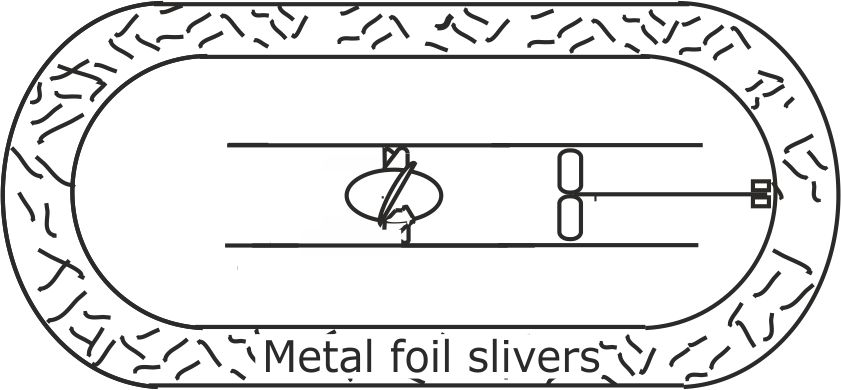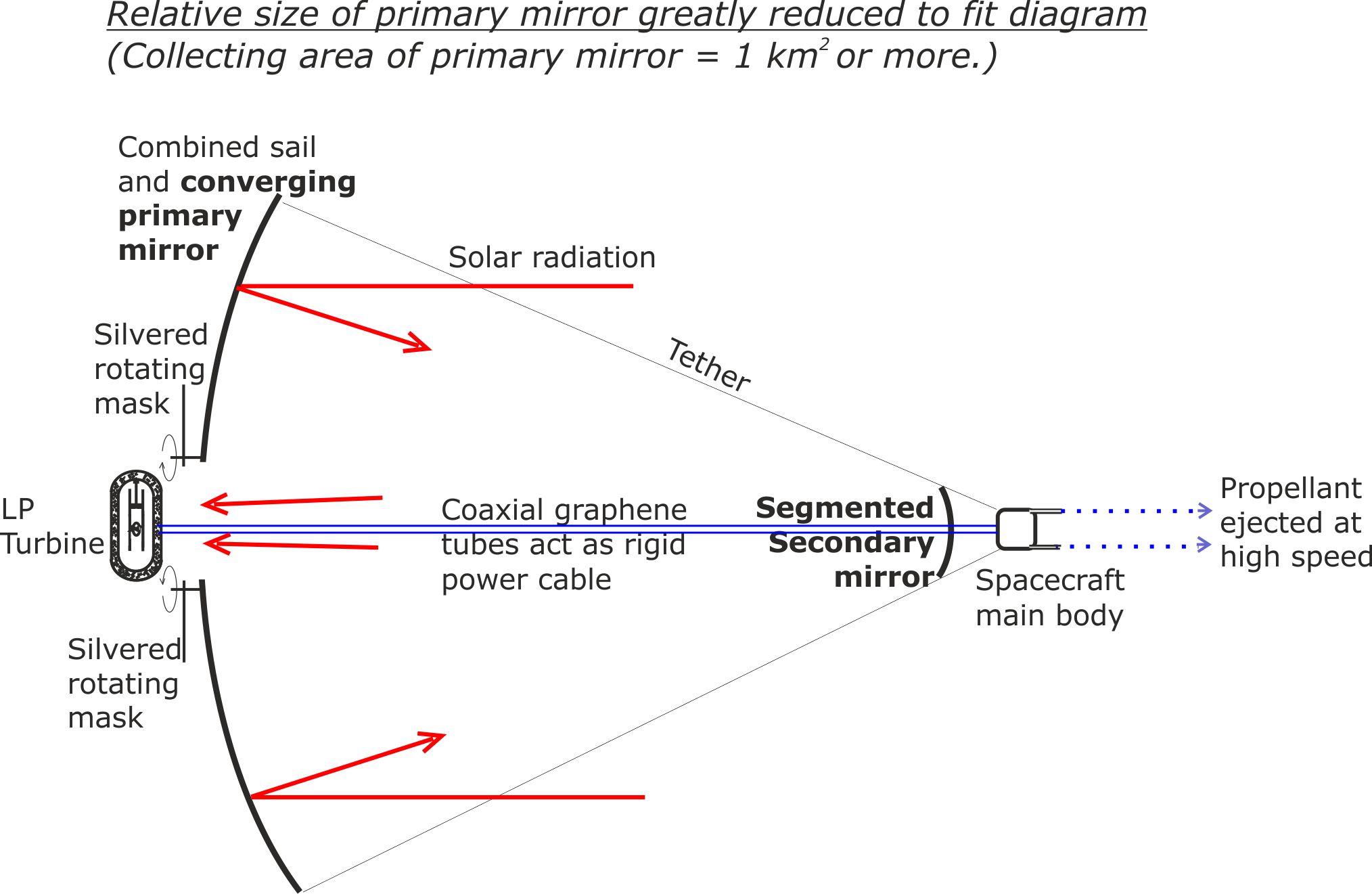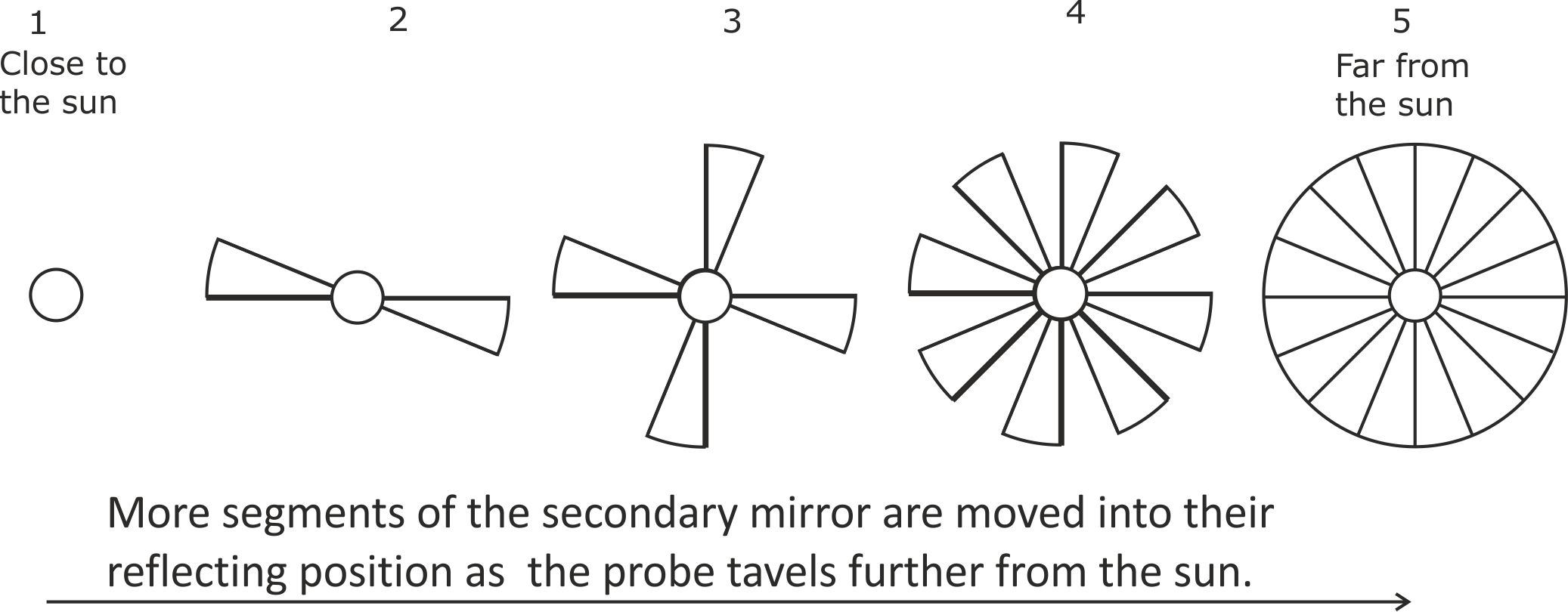Contents
1 Low cost rocket fuel
2 Self healing LP Turbines for space application
3 A power supply for probes exploring Venus
4 Ion thrust engines
5 Interstellar space probes
6 Protecting Earth from asteroid impacts
7 The heat death of the universe
1 Low cost rocket fuel
Hydrogen reacting with oxygen is NASAs preferred rocket fuel [NASA - Liquid Hydrogen--the Fuel of Choice for Space Exploration ]
This fuel can be made by passing an electric current through water so that it splits into hydrogen and oxygen.
These gases then need to be cooled to very low temperatures so that they become liquids.
In an LP Turbine era the water splitting and liquefaction processes will be e complimentary, with water splitting consuming electricity and liquefaction producing it.
On long missions, LP Turbines can help to keep the liquefied gases cold by pumping heat out of them to generate electricity.
2 Self healing LP Turbines for space application
To reduce the loss of working gas in the event of an LP Turbine being punctured by a meteorite, some form of self healing for the casing is required.
Here is one option.
The LP Turbine could be protected by an outer gas filled jacket. Small slivers of metal foil would float around inside the jacket. In the event of the jacket being punctured by a small meteorite, some gas would escape but this would also draw metal slivers towards the hole, sealing it.

Figure 1. This is just one of several design options for a self healing LP Turbine for use in the vacuum of space.
3 A power supply for probes exploring Venus
The high temperature and atmospheric pressure on the surface of Venus make it a challenging environment to explore.
The lower atmosphere of Venus is 96.5% carbon dioxide, 3.5% nitrogen plus traces of other gases including sulphur dioxide. The surface temperature of the planet is 462oC and the atmospheric pressure at its surface is 93 times greater than at the surface of the Earth.
LP Turbines have two features that make them particularly attractive for probes working on Venus.
- An LP Turbine does not have to be a sealed unit. It can include small holes in its casing. These would allow atmospheric gases to flow into the turbine chamber equalising internal and external pressures.
- LP Turbines generate electricity at the expense of cooling. So a lagged LP Turbine in thermal contact with instruments could be used to cool the instruments to about 31o [Below this temperature the high pressure carbon dioxide in the atmosphere would start to liquefy.]
Sealed LP Turbines could be used to power flying craft for exploring the corrosive upper atmosphere of Venus, looking for phosphine (PH3) and evidence of microbial life. The lack of water vapour in the Venusian atmosphere suggests that our chances of discovering life are low. But a flying craft that can roam the Venusian atmosphere for months or possibly years would allow us to make the best of a low probability.
4 Ion thrust and plasma engines
These engines are used for accelerating spacecraft in the vacuum of space because they offer very high fuel efficiency. [For these engines, efficiency means providing the maximum change in speed for a spacecraft, for the minimum load of propellant that needs to be lifted into space.]
But they only produce a tiny amount of thrust because of the small mass of the material ejected.
Ion thrust engines are currently the market leaders, partly because they require less electrical power to be generated onboard the spacecraft. But plasma and other types of high propellant speed/low propellant mass engine may come to the front in an LP Turbine era.
In an ion thrust engine, an electric field accelerates positive ions which are then neutralised and fired out of the back of the spacecraft at very high speed. The reaction force produces a far smaller increase in speed for the more massive spacecraft.
According to existing designs, either solar panels or radioactive sources are used to generate the electricity required, depending on how far the craft is from the sun.
Xenon is the preferred propellant for ion thrust engines because only a small amount of electricity is required for the ionisation process. But xenon is rare and expensive.
The electricity supply problem can be considerably reduced if an LP Turbine running on concentrated solar energy is used as the source of electricity.
This would allow cheaper alternative propellants requiring more ionisation energy to be used for the mission. In the case of plasma engines the benefits of replacing solar panels with LP Turbines is even greater because water could be used as the propellant.
Here is an introductory suggestion for those with greater specialist knowledge to improve upon.

Figure 2. The primary mirror serves the dual purpose of collecting solar energy for the LP Turbine and acting as a solar sail [https://en.wikipedia.org/wiki/Solar_sail]. This diagram shows the probe at a great distance from the sun, when all of the collecting power of the primary mirror is required to power the LP Turbine.
At this distance, powering the LP Turbine comes at the cost of reducing the efficiency of the sail by 50% because after two reflections, all the photons hitting the primary mirror are absorbed by the LP Turbine instead of being reflected back towards the sun.
To minimise the reduction in sail efficiency and prevent the LP Turbine overheating, three mechanisms are suggested.
- Silvered masks that rotate into a blocking position could be used to control the amount of solar energy falling on to the LP Turbine.
- The secondary mirror could be segmented to control the fraction of solar radiation that it reflects towards the LP Turbine.
- The curvature and focal length of the primary mirror could be altered by changing the tension in the tethers around its rim.
This is what a segmented secondary mirror might look like.

Figure 3. The secondary mirror could be made up of fold back segments, with all of the segments being folded out of the way when close to the sun.
As the probe moves further from the sun and the solar energy reflected by each segment decreases, more segments would gradually moved into their reflecting position.
A segmented primary mirror with gaps between the segments, as in configuration 4 above would be easier to bring to a focus than a single circular sheet mirror.
5 Interstellar space probes
These are probes that travel into deep space, far beyond the confines of the solar system. Our proposed ion thrust/plasma system could travel such distances, especially if used in a slingshot system that employed the gravitational pull of the outer planets to accelerate the probe.
The most ambitious interstellar project proposed to date is a visit to the nearest potentially habitable planet outside our solar system. This is Proxima b, a planet orbiting Proxima Centauri, a star 4.22 light years, away. [What It Would Take to Reach the Stars - Scientific American]. So, even a probe travelling at an impressive speed of 10% of the speed of light would take 42.2 years to get there. [Speed of light, c = 3 x 108 m/s]
We propose a modified version of the ion thrust/plasma engine for launching a fleet of miniature probes on this mission. The mother craft would be a variation on that illustrated in Figure 2 and would travel outwards from Earth until either lack of propellant or lack of sunlight prevented it from further increasing its speed. The coaxial graphene tube would then be used as a very long barrelled (possibly electromagnetic) gun, firing off multiple miniature probes in succession and giving them one last increase in speed.
Each time the mother craft fires off a probe it loses some momentum due to the recoil. But it may retain sufficient forward momentum that it also reaches Proxima b in two or three human lifetimes.
This would be an exciting inheritance project for future generations because the mother craft’s LP Turbine power supply and solar sail and would allow it to collect and transmit far more data than the pioneering miniature probes.
A sister ship, similar to the mother ship, but stripped of all features required for launching miniature probes could leave Earth orbit at the same time. This would reach Proxima b after the miniature probes, but before the mother ship.
There are also a lot more interesting places to visit beyond Proxima Centauri. The cost of additional trips to these more distant stars would fall rapidly once the research and development for the first mission had been completed.
This project would encourage children to think about the wonders of the universe and motivate some to take up careers in science or technology.
In an age when commercial pressures have conditioned humans to short term thinking, a stimulating long term project asking questions about the universal abundance of life itself might give us a new long term thinking philosophy, a sort of yang, to balance the yin of mindfulness.
6 Protecting Earth from asteroid impacts
The mining of asteroids for mineral resources arouses speculative interest but currently has few backers because of the high costs involved. These costs could fall dramatically if LP Turbines were employed as discussed in this article.
The author is not advocating this enterprise because the prospect of an almost limitless supply of replacement materials from space could make us more careless in the use of the finite resources of our home planet.
However, it would be prudent to develop the low gravity mining technology required by testing it on two or three asteroids of different compositions. This knowledge would come in useful one day if we are ever faced with the task of having to change the path of an incoming asteroid, to prevent it hitting Earth.
According to our proposal, material would be mined from the surface of the asteroid and then catapulted into space, so that the reaction force on the asteroid nudged it into a safer orbit. For a large asteroid, material would need to be ejected regularly over a period of months or years to make a significant change to the asteroids orbit. The asteroid will probably be spinning about its centre of mass. So the material has to be ejected at the correct time in each cycle, to ensure that the asteroid is deflected in the required direction.
The vector indicating the line of ejection of the material will also need to extend backwards through the asteroid centre of mass, otherwise the asteroid will tend to spin round rather than being nudged sideways.
Learning how to carry out mining in very low gravity will take time, research and money. But governments will be more willing to fund the project if costs can be defrayed by using similar technology for commercial asteroid mineral mining.
The basic physics of momentum transfer involved are the same as those employed in plasma and ion thrust engines. So for an asteroid with a composition that could supply suitable propellants, such motors could play a role in nudging its orbit.
Even if a newly discovered asteroid requires deflecting or fragmenting at short notice, making the use of nuclear explosives necessary, the prior experience of working in a low gravity asteroid environment during mining operations will simplify the process of emergency decision making.
7 The heat death of the universe
When Kelvin proposed his ‘heat death of the universe’ hypothesis in 1852, he assumed that all heat engine phenomena had to imitate Carnot’s heat engine by dumping their unused thermal energy into a low temperature heat sink, thus causing the entropy of the universe to increase.
Each natural heat engine process would lead to a drop in the temperature and an increase in the entropy of the universe, ultimately leading to its heat death, when entropy had reached its maximum possible value.
However, once the existence of low pressure internal energy sinks is recognised, it is no longer mandatory for entropy to increase when thermal energy is converted into mechanical energy. Consequently, alternatives to Kelvin’s heat death hypothesis become plausible.
You can find further details of the LP Turbine project by clicking here.
